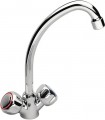Jet depth
Distance from the fixing point (for vertically mounted taps) or from the centre of the mounting hole (for horizontally mounted taps) to the middle of the spout. It is a characteristic that determines the "reach zone" of the tap.
Jet height
The jet height is usually specified for taps with horizontal installation (see "Type of installation"). It is measured from the base of the tap to the spout outlet. The large height of the spout is important primarily for kitchen models (see "Suitable for"), because it allows you to place large dishes in the sink. This parameter is directly related to the height of the spout (see above): the height of the jet cannot be greater than the height of the spout. Thus, in fact, one has to find a compromise between the height of the jet and the dimensions of the tap, especially if there is little space for its installation.
Stop valve
Material and design features of the valve(s) responsible for opening and closing water in the faucet.
—
Rubber. Material for valves in inexpensive single and double-handle faucets (see "Faucet Type"). Rubber is low-cost, easy to replace, and resistant to water with impurities (unlike ceramics). On the other hand, rubber valves have a relatively short lifespan — as they wear out, they begin to leak and need to be replaced from time to time.
—
Ceramic. These valves are based on a pair of metal-ceramic plates polished for maximum contact and sealing. They can be used in both handle and lever faucets (see "Faucet Type"). This material is much more durable than rubber, and in the case of a single-lever faucet, it also makes adjustment easier, as the friction between the plates is minimal, making it much easier to move the lever than with a ball valve. The downside of ceramics is their sensitivity to water contamination with solid particles — if they get between the plates, they can compromise the valve's seal. Therefore, it is recommended to install filters before such faucets.
—
Electromagnetic. A type of valve used in all contactless faucets (see "Faucet Type"), as well as some models of other designs — in particular, button and single-lever with touch. As the name suggests, an electromagnet is responsible for opening and closing the water in such mode
...ls. In most models, the valve has only two positions — "open" and "closed" — and does not allow for pressure adjustment. However, a temperature regulator may be provided — for example, in the form of a corresponding lever (see above). Electromagnetic valves are quite efficient but expensive, and they also require external power to operate.
— Ball. A type of valve originally developed for single-lever faucets (hence the tendency to call such devices "ball valves," which is technically incorrect). This valve is based on a spherical element with a special slot through which water is supplied; as the lever moves, the slot takes different positions, determining the water pressure and temperature. In household faucets, this type of valve is considered outdated and is used very rarely.Tap height
The height of the tap, measured from its base or lowest point to the highest point of the spout. The height of the spout partly determines the installation possibilities — in fact, this is the minimum vertical free space that is required for the tap. In addition, in models with horizontal installation (see "Type of installation"), the spout height is related to the jet height (see below).

